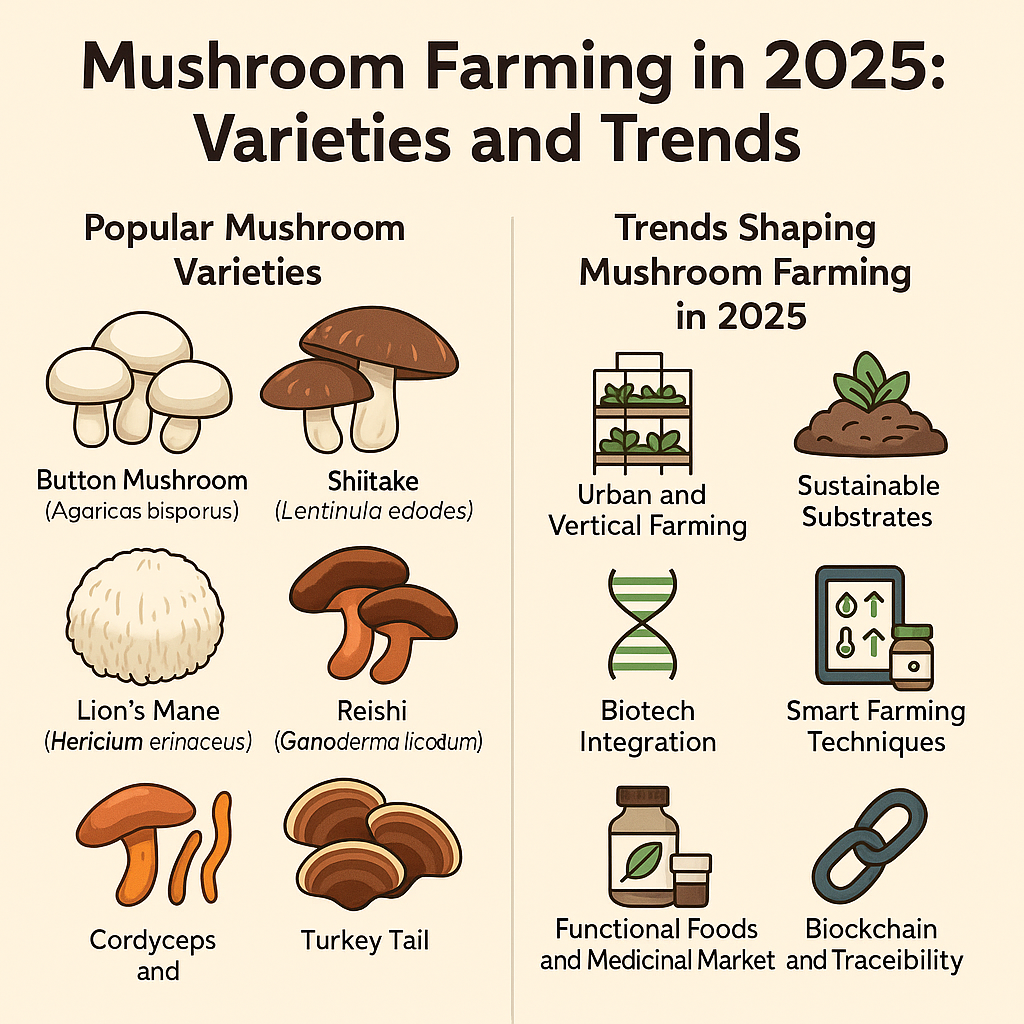-
Button Mushroom (Agaricus bisporus)
-
Still the most widely cultivated variety globally.
-
Grown primarily for mass-market consumption due to its mild flavor and versatility.
-
High demand in processed food and frozen food segments.
-
-
Oyster Mushroom (Pleurotus ostreatus)
-
Increasingly popular among small-scale and urban farmers due to low production costs and rapid growth cycle.
-
Consumers favor them for their delicate texture and umami flavor.
-
Several color variants like pink, yellow, and blue oysters are now trending in gourmet cooking.
-
-
Shiitake (Lentinula edodes)
-
Known for its medicinal properties and rich, earthy taste.
-
Favored in both Asian cuisine and the nutraceutical market.
-
Advances in sawdust block cultivation have made shiitake production more efficient.
-
-
Lion’s Mane (Hericium erinaceus)
-
Rapidly growing in demand due to cognitive health benefits.
-
Used in dietary supplements, teas, and functional foods.
-
Gaining popularity in North America and Europe for its crab-like flavor and therapeutic properties.
-
-
Reishi (Ganoderma lucidum)
-
Primarily cultivated for medicinal use rather than culinary.
-
Integral to the wellness and adaptogen trend in health markets.
-
Grown in controlled environments with a focus on extract quality.
-
-
Cordyceps and Turkey Tail
-
Though niche, these mushrooms are emerging strongly in functional food and pharmaceutical sectors.
-
Cultivation techniques have improved to allow more predictable yields in lab-based settings.
-
Trends Shaping Mushroom Farming in 2025
1. Urban and Vertical Farming
-
Urban mushroom farms using vertical racks, hydroponics, and container-based systems are proliferating.
-
Cities like Singapore, Amsterdam, and San Francisco are leading in rooftop mushroom farming.
2. Sustainable Substrates
-
Mushroom farmers are adopting agricultural and industrial waste (like coffee grounds, coconut husks, and cardboard) as substrates.
-
Circular economy models are being implemented, making mushroom farming one of the most eco-friendly forms of agriculture.
3. Biotech Integration
-
CRISPR and gene editing tools are being explored to enhance mushroom yields, disease resistance, and nutrient profiles.
-
Synthetic biology is enabling the production of rare mushroom compounds for pharma use without full-scale cultivation.
4. Smart Farming Techniques
-
Use of AI, IoT, and remote sensing is helping farmers optimize humidity, CO₂ levels, light, and temperature.
-
Mushroom-growing automation systems are becoming more accessible, allowing for precision farming even at smaller scales.
5. Functional Foods and Medicinal Market
-
Mushrooms are increasingly processed into powders, extracts, capsules, and beverages.
-
Functional products like mushroom coffee, chocolate, and protein bars are gaining mainstream traction.
6. Blockchain and Traceability
-
Blockchain is being used to track mushroom production from farm to consumer, ensuring quality and authenticity in medicinal mushroom markets.
Market Outlook and Consumer Demand
The global mushroom market is expected to exceed $100 billion by 2030, with a CAGR of over 9% from 2023 to 2025. Factors driving this growth include:
-
Rising vegetarian and vegan populations.
-
Increased awareness of mushrooms’ health benefits.
-
A surge in interest in natural immunity boosters post-pandemic.
China, India, the United States, and parts of Europe remain the dominant producers, but countries in Africa and South America are emerging as new players due to favorable climates and low labor costs.
Conclusion
Mushroom farming in 2025 is no longer just about growing button mushrooms in damp cellars. It has evolved into a high-tech, sustainable, and health-driven industry with global appeal. Whether for culinary enjoyment, health enhancement, or environmental sustainability, mushrooms are taking center stage in modern agriculture.
As technology advances and consumer preferences continue to shift, mushroom farmers who embrace innovation and diversify their offerings are poised for success in the years ahead.

